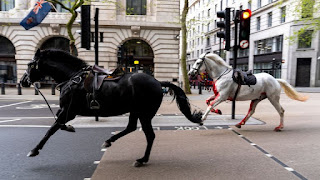Quaker and Vida's epic run
What's black and white and red all over? If the joke's punchline of yesteryear was 'newspapers,' then today it seems to be the very horses themselves. The alarming event unfolded in London between 8am and 9am on Wednesday 24 April 2024, and calls for interpretation.
Five Household Cavalry horses (four of them are named: Trojan, Quaker, Tennyson, and Vida) broke out of their signifying chains, two of them galloping five miles following the course of the Thames. They did not reach the beach, like "Doinel" in Les Quatre Cents Coups, but they arrived at Glamis Road, which has its own claim to fame. Macbeth was the Thane of Glamis at the beginning of that apocryphal play. Its castle was the scene of Duncan's murder.
Apparently frightened by something falling from height on a building site in Belgravia, the horses jumped, dumped their riders, and bolted past Buckingham Palace down The Mall, along The Strand, around The Aldwych, on and on to the east. They must have passed St Paul's and The Tower of London before giving up their plight at Glamis Road near Cable Street.
More than a week later, we took the chance to visit the Household Cavalry Museum. It was a sunny spring Sunday morning and we watched the 11am inspection on the parade ground as Big Ben sent its leaden circles, its metallic pulse out from Parliament Square. The museum staff were upright tight-lipped Brits who knew how to give nothing away but the establishment's view of things.
Seven strong black horses stand more or less patiently on the parade ground bearing the weight of paraphernalia and riders in full regalia while a small crowd of tourists respectfully keep a distance and video the mysterious ritual of a military inspection unfolding before them.
Out front on Whitehall two tall horses stand quite still in sentry boxes as tourists take turns to pose next to one or the other to have their photos taken. I watch one of these horses. He has a gentle eye and turns his head and neck to greet each new arrival. He drops his nose low and brings his muzzle close to the small baby in the arms of a short woman as she moves next to his shoulder.
A young man snaps to attention on the pavement and offers a salute to the soldier in the saddle. The intensity of his gaze forces the rider to acknowledge him, then, satisfied, he drops his salute and marches off alone into the crowd.
The museum contains a set of stalls where, on the other side of a thick perspex wall, three horses stand still wearing their heavy furniture, waiting for their call to duty.
The note next to the Farrier's Axe in a display case says it had a double purpose: the spike could be used to dispatch a badly wounded horse in battle, while the blade could cut off its feet to be taken back for registration.
In Trafalgar Square a diatribe is being delivered against Royalty and in favour of Republicanism. While the speaker rants about the lazy King lolling around on his wealth, we reflect on the scant 40% turnout at last week's London Mayor election. Something is rotten.
An artist remarks that the Red Horse of the Apocalypse is said to represent civil strife.
An article in the Spectator suggests that these horses buck and bolt on a regular basis, but once they are free, they usually run straight back to the barracks.
These two Household Cavalry horses became part of a real disruption emanating from something amiss near Buckingham Palace. It drove them five miles eastward. It testifies to a slackening of the ancient bond whereby excess and waste were contained in culture. The dust has barely settled, and I wonder what kind of listening is happening in the institution that houses them. Would the wise listening of a Bion or a Rickman be available in today's Army establishment? This epic run deserves close reading. Something real has broken free and these two horses have borne the brunt of it.
I suppose the key aspects here are: 1. horses are more afraid and vulnerable than we usually realise; 2. horses are linked with human civilisation in a way that invokes the mystery of life; 3. their actions and presence can provoke us to make meaning which in turn reveals things to us of our own minds.
Updates:
10 May: https://www.bbc.co.uk/news/uk-england-london-68988811
30 May, https://www.bbc.co.uk/news/articles/c80089rn7x7o
5 June: Quaker and Vida recovery article, and video turned out in Chilterns fields
14 June: Guardian reports on horses' participation in King's Birthday parade
15 June British Army press release
Invoked:
Shakespeare, Macbeth, and Hamlet
Revelation 6
Virginia Woolf, Mrs Dalloway
Edwin Muir, "The Horses"
Jacques Lacan, "Lituraterre" in Hurly-Burly 9, 2013, p. 29
Flora Watkins, "The terrifying life of a civilian support rider," Spectator Life, 26 April 2024 online
Wilfred Bion and John Rickman, "Intra-group tensions in therapy, their study as the task of the group," The Lancet, 27 November 1943
British Army update: https://youtu.be/Jjs41i-0mRc?si=xcsv9bvl-JnhOrOO
Provoked: Sylvia Plath, Whiteness; Andrew C Geer, Reckless, Pride of the Marines, Ted Hughes, The Horses




Comments
Post a Comment